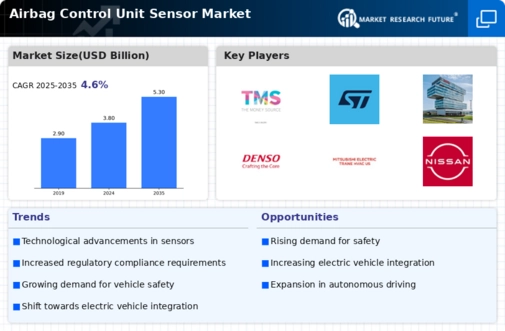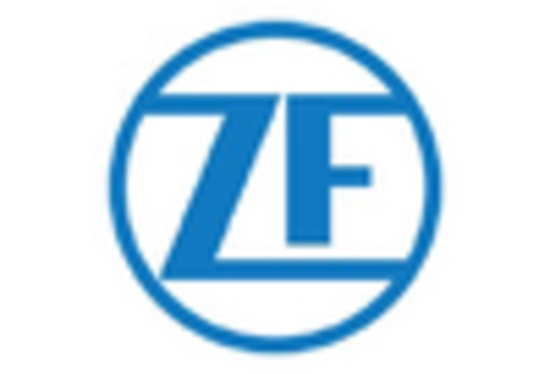Increasing Vehicle Production and Sales
The Airbag Control Unit Sensor Market is poised for growth due to the increasing production and sales of vehicles across various segments. As the automotive industry rebounds and expands, the demand for airbag control unit sensors is expected to rise correspondingly. Manufacturers are ramping up production to meet the needs of a growing consumer base, which in turn drives the need for enhanced safety features, including airbag systems. Recent data suggests that vehicle sales are projected to increase by approximately 5% annually, further fueling the demand for airbag control unit sensors. This upward trend in vehicle production not only supports the growth of the airbag control unit sensor market but also encourages innovation as manufacturers strive to differentiate their products through advanced safety technologies.
Rise of Electric and Autonomous Vehicles
The emergence of electric and autonomous vehicles is reshaping the Airbag Control Unit Sensor Market. As automakers pivot towards electric mobility, the integration of advanced safety features, including sophisticated airbag systems, becomes paramount. Electric vehicles often incorporate cutting-edge technology that necessitates the use of high-performance airbag control unit sensors. Furthermore, autonomous vehicles require enhanced safety measures to protect passengers in the event of an accident. This shift towards automation and electrification is expected to drive the demand for innovative airbag control unit sensors, as manufacturers seek to ensure the highest levels of safety. Market analysts predict that the increasing production of electric and autonomous vehicles will contribute to a substantial rise in the airbag control unit sensor market, potentially exceeding a valuation of several billion dollars by the end of the decade.
Regulatory Compliance and Safety Standards
The Airbag Control Unit Sensor Market is heavily influenced by stringent regulatory compliance and safety standards imposed by various authorities. Governments worldwide are mandating higher safety requirements for vehicles, which include the implementation of advanced airbag systems. These regulations compel manufacturers to invest in high-quality airbag control unit sensors that meet or exceed safety benchmarks. As a result, the market is likely to expand as companies strive to comply with these evolving standards. For instance, the National Highway Traffic Safety Administration has set forth guidelines that necessitate the integration of advanced airbag systems in new vehicle models. This regulatory landscape not only drives innovation but also increases the demand for reliable airbag control unit sensors, thereby propelling market growth.
Technological Advancements in Sensor Design
The Airbag Control Unit Sensor Market is experiencing a surge in demand due to rapid technological advancements in sensor design. Innovations such as MEMS (Micro-Electro-Mechanical Systems) technology are enhancing the precision and reliability of airbag sensors. These advancements allow for faster deployment times and improved accuracy in detecting collisions, which is crucial for passenger safety. As manufacturers integrate more sophisticated sensors into their vehicles, the market is projected to grow significantly. According to recent estimates, the airbag control unit sensor segment is expected to witness a compound annual growth rate of over 7% in the coming years. This growth is driven by the increasing focus on enhancing vehicle safety features, which is becoming a priority for both consumers and manufacturers alike.
Consumer Awareness and Demand for Safety Features
Consumer awareness regarding vehicle safety is a pivotal driver for the Airbag Control Unit Sensor Market. As individuals become more informed about the importance of safety features, there is a growing demand for vehicles equipped with advanced airbag systems. This heightened awareness is influencing purchasing decisions, with consumers increasingly prioritizing safety over other factors. Consequently, automakers are compelled to enhance their offerings by integrating state-of-the-art airbag control unit sensors into their vehicles. Market Research Future indicates that a significant percentage of consumers are willing to pay a premium for vehicles that boast superior safety features, including advanced airbag systems. This trend is likely to sustain the growth of the airbag control unit sensor market, as manufacturers respond to consumer preferences by investing in innovative safety technologies.


















Leave a Comment